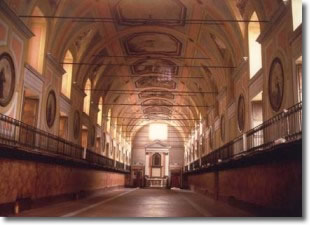
- The Lazzaretto Hall
The complex was built on the site of the 15th-century Palazzo of Ser Gianni Caracciolo, Great Seneschal of the Kingdom and the lover of Queen Giovanna II. It comprises the Church and the hospital of the Hospital friars of S. Giovanni di Dio founded in 1587, which is now the seat of the San Lorenzo - Vicaria constituency.
The structure of the ancient palace is still visible in the entrance portal, which is a large polylobed arch in florid Gothic style; at the base of the vestibule the 15th-century walls can be seen. The whole place is built around two cloisters on different levels because of the sloping site.
Worth a visit are the Lazzaretto Hall and the Church dedicated to S. Maria della Pace in memory of the end of hostilities between Philip IV King of Spain and Louis XIV King of France.
The Church
Building began in 1629 on a plan by Pietro de Marino and completed in 1659. The architectural structure is a Latin cross. There are three chapels on each side. The floor is of majolic and terracotta tiles made by Donato Massa and designed by Domenico Antonio Vaccaro. The apse is by Nicola Tagliacozzo Canale.
The Lazzaretto Hall
Access to the hall is by the staircase whose entrance is on the left of the vestibule.
It is called the Lazzaretto Hall because it was here that lepers and, in times of plague, numerous plague-victims were gathered. It is 60 metres long, 10 metres wide and 12 metres high. At the end of the hall, a valuable marble altar commissioned in the 18th century separates the hall from the area which was at that time a medical room.
Halfway up along the wall there is a balcony, from where food and drink were served to in-patients to avoid contagion. Above the gallery, between the windows and below the vaulted roof there are frescoes by Giacinto Diano and Andrea Viola showing the Virgin Mary and saints of the order of S. Giovanni di Dio.